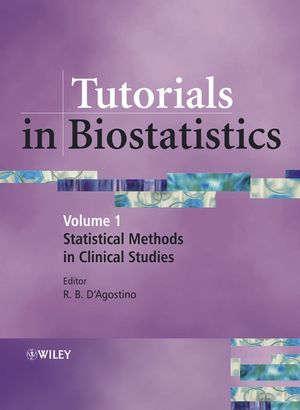Tutorials in Biostatistics, Volume 1, Statistical Methods in Clinical StudiesISBN: 978-0-470-02365-5
Hardcover
464 pages
November 2004
 This is a Print-on-Demand title. It will be printed specifically to fill your order. Please allow an additional 15-20 days delivery time. The book is not returnable.
|
||||||
Preface to Volume 1.
Part I: OBSERVATIONAL STUDIES/EPIDEMIOLOGY.
1.1 Epidemiology.
Computing Estimates of Incidence, including Lifetime Risk: Alzheimer’s Disease in the Framingham Study. The Practical Incidence Estimators (PIE) Macro. (Alexa Beiser et al).
The Applications of Capture-Recapture Models to Epidemiological Data. (Anne Chao et al).
1.2 Adjustment Methods.
Propensity Score Methods for Bias Reduction in the Comparison of a Treatment to a Non-Randomized Control Group (Ralph B. D’Agostino Jr.).
1.3 Agreement Statistics.
Kappa Coefficients in Medical Research (Helen Chmura Kraemer et al).
1.4 Survival Models.
Survival Analysis in Observational Studies (Kate Bull and David J. Spiegelhalter).
Methods for Interval-Censored Data (Jane C. Lindsey and Louise M. Ryan).
Analysis of Binary Outcomes in Longitudinal Studies Using Weighted Estimating Equations and Discrete-Time Survival Methods: Prevalence and Incidence of Smoking in an Adolescent Cohort (John B. Carlin et al).
Part II: PROGNOSTIC/CLINICAL PREDICTION MODELS.
2.1 Prognostic Variables.
Categorizing a Prognostic Variable: Review of Methods, Code for Easy Implementation and Applications to Decision-Making about Cancer Treatments (Madhu Mazumdar and Jill R. Glassman).
2.2 Prognostic/Clinical Prediction Models.
Development of Health Risk Appraisal Functions in the Presence of Multiple Indicators: The Framingham Study Nursing Home Institutionalization Model (R. B. D’Agostino et al).
Multivariable Prognostic Models: Issues in Developing Models, Evaluating Assumptions and Adequacy, and Measuring and Reducing Errors (Frank E. Harrell Jr et al).
Development of a Clinical Prediction Model for an Ordinal Outcome: The World Health Organization Multicentre Study of Clinical Signs and Etiological Agents of Pneumonia, Sepsis and Meningitis in Young Infants (Frank E. Harrell Jr. et al).
Using Observational Data to Estimate Prognosis: An Example Using a Coronary Artery Disease Registry (Elizabeth R. DeLong et al).
Part III: CLINICAL TRIALS.
3.1 Design.
Designing Studies for Dose Response (Weng Kee Wong and Peter A. Lachenbruch.).
3.2 Monitoring.
Bayesian Data Monitoring in Clinical Trials (Peter M. Fayers et al).
3.3 Analysis.
Longitudinal Data Analysis (Repeated Measures) in Clinical Trials (Paul S. Albert).
Repeated Measures in Clinical Trials: Simple Strategies for Analysis Using Summary Measures (Stephen Senn et al).
Strategies for Comparing Treatments on a Binary Response with Multi-Centre Data (Alan Agresti, and Jonathan Hartzel).
A Review of Tests for Detecting a Monotone Dose–Response Relationship with Ordinal Response Data (Christy Chuang-Stein and Alan Agresti).



